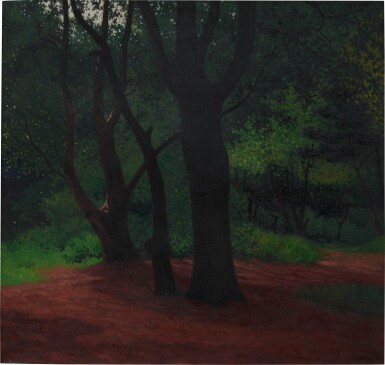
Félix Vallotton
Sous-bois, trois grands arbres, 1919
Lot Closed
December 15, 01:16 PM GMT
Estimate
260,000 - 350,000 CHF
Lot Details
Description
Félix Vallotton
1865 - 1925
Sous-bois, trois grands arbres, 1919
Oil on canvas
Signed with the artist's stamp and dated lower right
83.5 X 87.5 cm (unframed); 105 x 110 cm (framed)
To view Shipping Calculator, please click here
Galerie Paul Vallotton, Lausanne, no. 976
Private collection, Switzerland
Marina Ducrey in collaboration with Katia Poletti, Félix Vallotton (1865-1925). L’oeuvre peint, Catalogue Raisonné, Milan/Lausanne/Zurich, 2005, vol. III, p. 714, no. 1308, ill. in colour
"I dream of painting that is free from any literal following of nature. I would like to recreate landscapes only with the aid of the feeling which they evoked in me, a few basic big lines and one or two details selected without any precise connection with time or lighting. In essence, that would be something like a return to the celebrated ‘historical landscape’ And why not?" Vallotton’s diary, 5th October 1916.
The current work, painted in 1919, is an excellent example of Vallotton’s landscape technique which he himself described as paysage composé. The artist made numerous plein air sketches which served as studies for finished invented landscapes. Wishing to free himself from a literal depiction of nature, Vallotton created meticulously designed compositions, a mixture of memory and imagination, which he completed when back in his studio.
In Sous-Bois, trois grandes arbres, Vallotton has pared down the composition to the essentials. Three dark, almost monochromatic trees, described in geometric shapes, stand out against the brilliant and saturated greens of the woods and undergrowth beyond. A forest path, painted in dusty pinks, winds into the picture frame creating depth. The importance of the juxtaposition of a limited number of colours is underlined in the artist’s description of the work in his Livre de Raison, a catalogue of his work which he compiled throughout his career: “paysage sous bois, trois grands arbres sur fond verdures mêlées, 1er plan terrain rose (T88-82)".
The contrast between light and shade dominates the composition, giving it an intense and enigmatic quality. The dominant shadows contrast with the gentle warm pinks in the foreground further adding to the eerie atmosphere. Colours are applied in a flat technique with little modelling. The result is dreamlike composition, where people are noticeably absent.
Together with seascapes, forest compositions are common in this period immediately succeeding the First World War. The subject may depict the Bois de Boulogne which Vallotton painted on several occasions. It is reminiscent of landscapes by the 19th century Barbizon school and artists such as Jean-Baptise-Camille Corot. However, with his unusual colours and perspective, Vallotton offers a resolutely modern interpretation of this classical subject.
